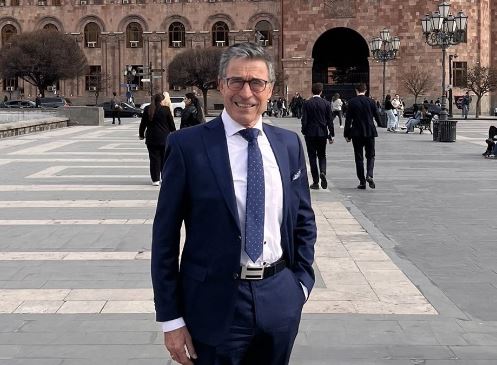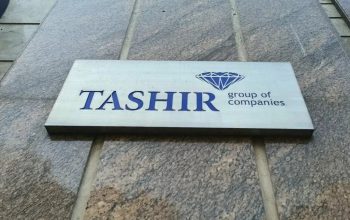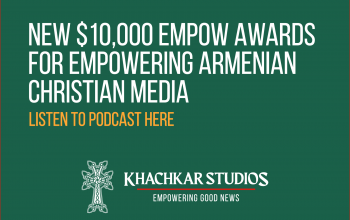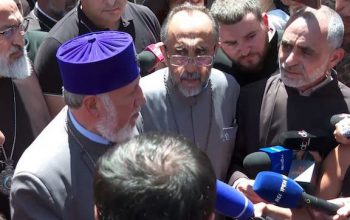At a time of deep geopolitical tumult in Armenia, the former secretary general of NATO visited the country two days ago and proposed providing Armenians with Western weaponry and security guarantees.
But the former official, Anders Fogh Rasmussen, was visiting as a private consultant, making it unclear whose interests and point of view he was representing.
On the two-day visit Rasmussen met with Armenian Prime Minister Nikol Pashinyan, as well as the minister of defense and chair of the national security council. He also posed for a photo at the Lachin Corridor, the road connecting Armenia to Nagorno-Karabakh that has been blocked by Azerbaijan for more than three months as Baku tries to strong-arm Armenia into signing a comprehensive peace agreement.
“The EU must push Azerbaijan to lift the blockade,” he wrote in a tweet. “If not, we risk a humanitarian catastrophe.”
While in Yerevan he also met with journalists and laid out a vision for the resolution of the status of Nagorno-Karabakh, the Armenian-populated territory in Azerbaijan that has been the core of the decades-long conflict between the two sides.
He envisaged Karabakh as part of Azerbaijan but with a “special status” protected by an armed international peacekeeping mission with a “robust mandate,” according to an account of the meeting by news website CivilNet. The territory would also be surrounded by a demilitarized zone. Ideally, he said, the peacekeeping mission would be mandated by the United Nations with Russian consent and with American participation.
“With all respect for the European Union, when it comes to hard security, there’s only one power on Earth we can trust, and that is the United States,” he said.
He also proposed the European Union providing military aid to Armenia to buy Western weapons.
“The European Union has a special fund called the European Peace Facility, which primarily until now has been used for Ukraine for many good reasons. But we could also consider helping Armenia within the framework of that fund. That could be [to] help to purchase Western armament, weapons, and military equipment,” he said.
Much of Rasmussen’s vision for the resolution of Karabakh’s status has echoed Yerevan’s; Armen Grigoryan, the chair of the national security council, just days earlier proposed a special status with an international peacekeeping mandate and demilitarized zone.
The element of European and American military support, though, was relatively novel, and came amid a deepening crisis between Armenia and its traditional security partner, Russia.
Just days before Rasmussen’s visit, Armenia announced that it was further reducing its participation in the Collective Security Treaty Organization (CSTO), the Russia-led political-military alliance. That took place against the backdrop of a broader Armenian disillusionment with Russia’s inability or unwillingness to push back against Azerbaijani incursions in Armenia or the blockade in Karabakh.
Meanwhile, the European Union has been taking a larger role, most notably by deploying a civilian monitoring mission to Armenia’s border with Azerbaijan.
Where all of this is leading is unclear, as is Rasmussen’s role in it.
He came in his capacity as the head of Rasmussen Global, a consulting firm that has lately been closely working with Ukraine on a plan for Western security guarantees there. He said he came on the invitation of the Armenian government, but did not elaborate.
The firm’s communications director did not respond to queries from Eurasianet about how his involvement in Armenia came about, who is paying him, and if he is playing any role in the formal EU or any other mediation of the conflict.
In his discussion with the journalists, Rasmussen said he saw no reason that CSTO membership would have to be an obstacle for the Western-led vision he laid out. “Obviously it’s at least a challenge communicating this to a Western audience, that Armenia is still a member of CSTO, but we have seen cooperation between Armenia and NATO, for instance, in the past,” he said. “So CSTO membership is not an obstacle in itself. It can go in parallel.”
Rasmussen’s interlocutors in Yerevan made little comment on his proposals for Western military partnership. Pashinyan’s office said merely that the two “exchanged ideas on regional developments and security challenges.”
At a press conference later, Pashinyan did not touch on Rasmussen’s visit or relations with the West, but reiterated his criticism of the CSTO.
“My assessment is that the CSTO, willingly or unwillingly, is leaving the Republic of Armenia,” he said. And this worries us.” Still, he insisted that he “didn’t see a crisis” in relations with Russia in spite of “some mutual concerns.”
Joshua Kucera
Source: Eurasianet.org




